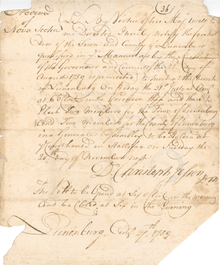Writ of election
A writ of election is a writ issued ordering the holding of an election. In Commonwealth countries writs are the usual mechanism by which general elections are called and are issued by the head of state or their representative. In the United States, it is more commonly used to call a special election for a political office.

United Kingdom
In the United Kingdom, a writ is the only way of holding an election for the House of Commons. When the government wants to or is required to dissolve Parliament, a writ of election is drawn up for each constituency in the UK by the Clerk of the Crown in Chancery.[1] They are then formally issued by the monarch.
Where a single seat becomes vacant, a writ is also issued to trigger the by-election for that seat.
Canada
In Canada, a writ is the only way of holding an election for the House of Commons. When the government wants to or is required to dissolve Parliament, a writ of election is drawn up for each riding in Canada by the Chief Electoral Officer.[2] They are then formally issued by the Governor General.
Where a single seat becomes vacant, a writ is also issued to trigger the by-election for that seat.
Australia
In Australia, writs for election are issued by the Governor-General for the House of Representatives within 10 days of the dissolution or expiration of the House and by the state governors for the election of senators for their respective states, while writs for the election of territory senators are issued by the Governor-General.[3]
State governors also issue the writs for elections in the state legislatures. In some states and territories of Australia, such as New South Wales, South Australia, Victoria and the Australian Capital Territory, it is normally required by law that the parliament must run its full term before writs are issued. Early dissolutions are allowed by the Governor in those states and by the federal Minister for Territories for the Australian Capital Territory, but only if certain objective criteria are met—in particular, if the parliament is unable to agree on the annual budget.
The writs are issued to the relevant Electoral Officer or Returning Officer, as the case may be, who returns them after the election has been held within a fixed period.[4]
United States
In the United States, this writ is issued mainly by state governors for filling vacancies in the United States House of Representatives, the United States Senate, or the states' own legislatures.[5]
References
- "By-elections". The United Kingdom Parliament. Retrieved 27 March 2011.
- Marleau, Robert; Montpetit, Camille. "The House of Commons and Its Members – The Writ of Election". House of Commons Procedure and Practice. Retrieved 27 March 2011.
- Constitution ss.12 and 32; Commonwealth Electoral Act 1918 (Cth) ss. 151 and 154
- "Federal Election Timetable". Australian Electoral Commission. Retrieved 27 March 2011.
- "An Act Concerning United States Senate Vacancies". Connecticut General Assembly. Retrieved 27 March 2011.